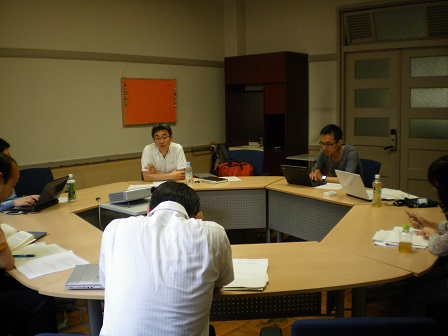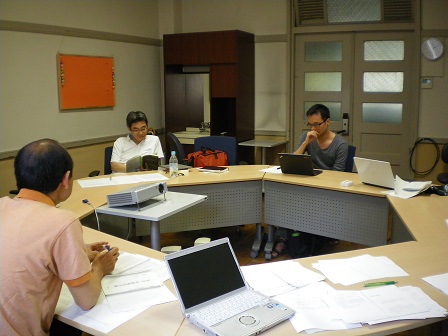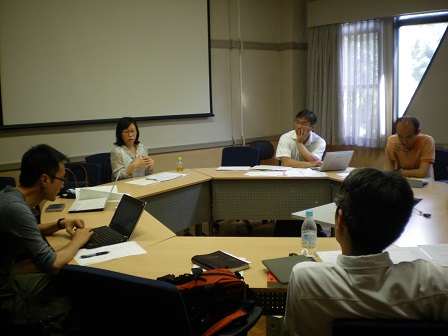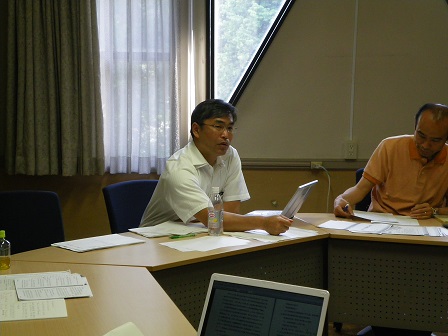Report: Reading Group on Sun Ganlu
On May 17th and 31st, CPAG hosted two reading groups on the works of Sun Ganlu, a contemporary Chinese writer who is commonly regarded as one of the so-called “Avant-guard” cohort in 1980s and after.
The reading group on May 17th, presided over by Professor Ishii Tsuyoshi, concentrated on Sun Ganlu’s short story, “Yi Qin E” (《忆秦娥》) written in early 1990s. With techniques of modernism such as self-reflection and double-narrative, the main plot of the short story is about the memory of the protagonist of a dead woman, “Su,” he met with in his childhood. The whole story consists of fragments of recollections, digressions of literary studies, anachronistic montages of cultural references, leaving thousands of problems to the reader.
Professor Ishii introduced the literary-historical background around 1990s against which Sun made his debut in contemporary Chinese literature, pointing out the self-conscious influence of Sun’s birthplace-Shanghai-on his writings. For Shanghai, a city full of experience of being colonized is a place without any substantial foundation, whilst Sun insists that his own “rootedness” lies in this foundationless status of Shanghai. Relevant to this insistence was Sun’s statement that “Su” in his works was nothing but a metaphor and a transformation.
Following Professor Ishii, Tan Renan noticed that traces of the influence of Shanghai could be detected in the story with regard to its implicit background. References to daily life items in early modern period of Shanghai indicate, then, that the whole story is staged in the so-called “old Shanghai.” Tan also raised the problem concerning the relationship between this short story and the trend of “private writings” triumphant in 1990s. A famous debate between the literary critic Li Tuo and another literary student, Wu Liang, was mentioned as a frame of reference, under the light of which the politicity of Sun’s story was put on the stage.
Into the problematic as to what extent the story contains elements of “the political” jumped Wang Qin’s comment. Picking up Professor Ishii’s mentioning of the “metaphor and transformation” function of “Su” in the story, he argued that one might read “Su” as a representation of modernity, which, being a container without limit, went beyond any form or representation of which literature is capable. In this sense, the whole story might be read as a reflection, or reconsideration of the “usage” of literature-especially modernist literature-at a historical moment when the political potentiality of 1980s’ “Avant-guard” writings seemed to be exhausted.

Professor Lin Shaoyang furthered the problematic of “metaphor and transformation” by casting some light on the problem of translation. According to him the mechanism of translation must be multilayered, since, in correspondence to Sun’s own accounts in an interview where it was said the task of the writer is to “translate” his innermost feelings into language, the work of translation must not be limited to natural languages. Rather, writing and reading constitute two kinds of translation call for hermeneutics. Professor Lin also mentioned the disparity between men and women, between father and mother, for the protagonist in the story.
Sugitani Kota then gave an existentialist reading of the text by concentrating on the equivalence between the “I” and the book established on an intertextual reading of Sun’s works. In this light the “Yi Qin E” was read, on one hand, as a record of the failure of Bildungsroman, while on the other the requirement of reading oneself was connected with the existentialist ethics put forward for example by Jean Paul Sartre. The “self” surfaced in the short story thus was understood in a particular way in which literature and the development of the protagonist could be merged together in confrontation with the outside world.
The reading group on May 31st discussed Sun Ganlu’s “Qing Nüren Cai Mi” (《请女人猜谜》), a short story published in 1988 in Chinese and then translated by Professor Iizuka into Japanese in 1995. The story seems to be without any plot or development; rather, it is all about the protagonist’s description of the two figures-“Shi” and “Hou”-who strangely have no self-identity.
Professor Ishii firstly gave a summary of the discussion of the first group reading. The heroine “Su” is closely related to the author’s diaspora experience of Shanghai; on the other hand, as a metaphor “Su” could be read as representing modernity per se. After that, in reference to Sun’s essay on Shanghai, Professor Ishii called for attention of the significance of the name “Hou” in the “Qing Nüren Cai Mi”: in contradistinction to “Su,” which seems to have spatial implications, “Hou” seems to be an indication of temporality. The term “Shi,” which is name of another figure, in comparison, originally refers to a room, the space of room. Professor Ishii then put forward the question concerning the so-called “old man” at the end of the story: what does oldness mean here? Why is it relevant to writing?

Yoko Nii’s comment followed Professor Ishii’s introduction by unfolding several clues laid out in the story. The most crucial point is about the relationship between literary writing and the realization of one’s individual/private dream or fantasy: is the process of realization accompanied by “unfreedom”? Fantasy in itself is something closed to others; for the author “woman” is a figure of the other (and of reality as such). Only through the form (of writing short story) could one be understood by others. But it is through the same formalization that the “nature” of dream or fantasy would be dismissed.
Professor Suzuki Masahisa mentioned that Chinese modernism was intended as a confrontation of traditional Chinese realism. Focusing solely on language, this story could be read as representing the failure of correspondence between reality and language and the repression of freedom in the form of representation. So the story is also about the limit of (the possibility of representation of) the language, of literary writing, so much so that figures in the story seem not to be Chinese?nor they seem to be foreigners. In this sense, these figures in the story might be said to be beings without any place; for this reason, the lack of focus in general paradoxically enables the ecriture of the story. Wang Qin followed by taking the story to be a typical modernist work in 1980s’ China. It tries to deconstruct all forms of literary writing by putting forward only pseudo-plots.

Tan Renan raised the question of “liar.” The intervention of the so-called “meta-language” de-justifies the whole formal structure of literature. But on the flipside, in the wake of deconstruction, what would this kind of modernist writing provide us? Professor Suzuki agreed that Sun’s later writings after 1990s affirmed in one sense the dilemma of modernism. While many other modernist writers-including Mo Yan and Yu Hua-tend to write neo-historical novels, Sun does not follow this suit. Rather, the limit of temporality of the story is ambiguous and fragmented.

Qi Jinying argued against the idea of reading this story in a deconstructive way. On the contrary, she suggested that one might interpret the story as an unfolding of the protagonist’s inner life, insomuch as the narrator tried hard to control “the other within oneself.” “Hou” is an untouchable “other” for the narrator; but the framework in which the narrative is situated has nothing to do with, or, more precisely, stands on the different level from, reality. The structure in which “Shi” and “Hou” appear in the story is an effect of iteration.

Professor Nakajima Takahiro mentioned that this story was very similar to Blanchot’s writings with regard to ways of repetition. Another element concerning the story is the possible relationship between modernism and the so-called “searching the root” trend in 1980s. At this point Professor Nakajima also showed doubts as to if the story was really related to Sun’s personal background of Shanghai.

(報告:王欽)




